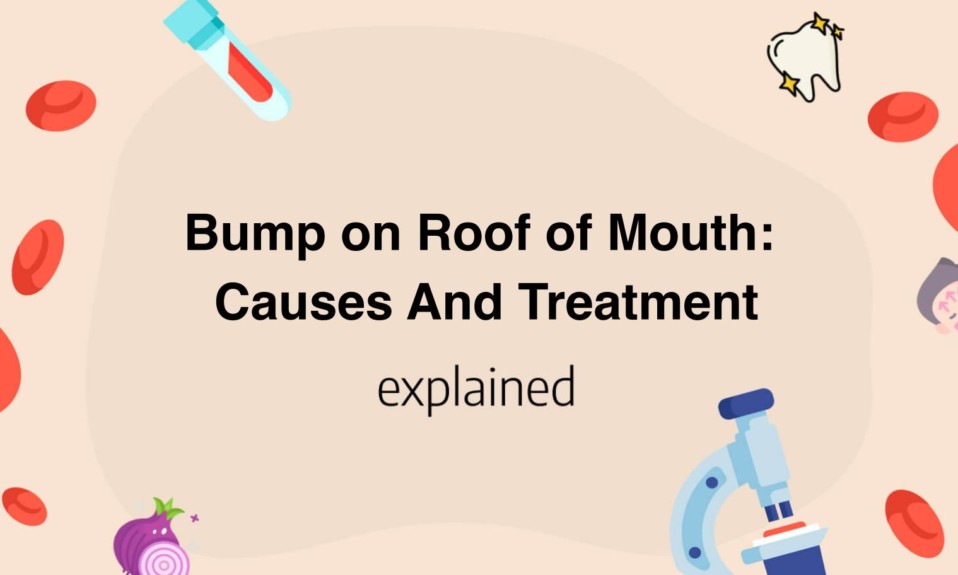If you’ve ever noticed a mysterious bump on the roof of your mouth, you’re not alone.
This common issue can cause discomfort and concern for many people.
While there are several possible causes of bumps on the roof of the mouth, knowing the underlying reasons can help you determine the best treatment plan.
In this article, we’ll explore the potential causes of these bumps and offer some tips on how to manage them.
Understanding the Anatomy of the Roof of the Mouth
The roof of the mouth is called the palate, which is divided into two parts: the hard palate and the soft palate.
The hard palate is the front part of the palate, made up of bone and covered by a layer of mucous membrane.
It serves as a divider between the mouth and the nasal cavity, allowing us to breathe and eat at the same time.
The soft palate is the back of the palate, made up of muscle and connective tissue covered by mucous membrane.
It has an important role in speech and swallowing.
When we swallow, the soft palate moves upward to seal off the nasal cavity.
When we speak, it helps to create different sounds by controlling the flow of air from the mouth and nose.
The roof of the mouth also contains two small projections called the uvula and the tonsils.
The uvula is the teardrop-shaped structure that hangs from the back of the soft palate.
Although it is often associated with snoring and sleep apnea, it actually plays a role in speech and swallowing.
The tonsils are located on both sides of the back of the throat, on the border between the mouth and the pharynx.
They are part of the immune system, helping to fight off infections.
However, they can become infected themselves, leading to tonsillitis.
In addition to its important functions in breathing, eating, and speaking, the roof of the mouth can also provide valuable clues to a person’s overall health.
For example, a white or red patch on the palate could be a sign of oral cancer, while a sore or lesion could indicate an infection or other condition.
Regular dental check-ups and self-examinations can help to detect these and other potential health issues.
In conclusion, understanding the anatomy of the roof of the mouth can help to promote good oral and overall health.
By knowing the different structures and functions of the palate, we can better appreciate the complex interplay between our mouths, noses, and throats, and how they contribute to our ability to breathe, eat, and speak.
So, it is essential to take proper care of our health by having regular dental checkups and taking preventive measures to ensure good health in the long term.

Common Causes of a Bump on the Roof of the Mouth
The development of a bump on the roof of the mouth is not an uncommon occurrence, and there are several reasons as to why it may occur.
Firstly, individuals who frequently suffer from canker sores may find themselves developing bumps on the roof of their mouth due to the trauma caused by the sore.
Secondly, oral cancer can manifest as a bump on the roof of the mouth, usually alongside other symptoms such as pain, difficulty swallowing, and numbness.
Thirdly, a bump on the roof of the mouth can be caused by a mucocele as a result of an injury to the salivary gland.
Fourthly, some individuals may develop a bump on the roof of their mouth as a result of an allergy, either to food or other environmental factors.
Finally, dental infections or abscesses can cause bumps on the roof of the mouth.
If you notice a bump on the roof of your mouth, it is important to visit a healthcare professional for proper diagnosis and treatment.
While it may be tempting to ignore the bump, especially if it isn’t causing any pain or discomfort, it is important to rule out any serious underlying conditions such as oral cancer.
Treatment for a bump on the roof of the mouth will depend on the underlying cause, and can range from simple remedies such as salt-water rinses for canker sores, to surgical intervention for oral cancer.
In conclusion, if you develop a bump on the roof of your mouth, don’t ignore it.
Seek professional advice and treatment, and be sure to discuss with your healthcare provider any concerns or questions you may have.
Remember, prevention is always better than cure, so maintain good oral hygiene and be mindful of the foods and environmental factors that may trigger an allergic reaction leading to a bump on the roof of your mouth.
Oral Cancer: Identifying the Signs and Symptoms
Oral cancer is a type of cancer that affects the mouth and throat area.
It is important to know the signs and symptoms of oral cancer in order to detect it early and receive prompt treatment.
There are a few common signs and symptoms of oral cancer that everyone should be aware of.
A persistent sore throat and difficulty swallowing are two of the most common symptoms of oral cancer.
Other symptoms include unexplained weight loss, white or red patches in the mouth, and mouth pain that does not go away.
It is important to note that not all of these symptoms necessarily indicate oral cancer, but they should be evaluated by a healthcare professional to determine the underlying cause and appropriate treatment.
People who smoke or use tobacco products are at a higher risk of developing oral cancer, as are those who consume alcohol excessively.
Regular check-ups with a doctor or dentist can help detect oral cancer early and improve chances of successful treatment.
One way to reduce the risk of developing oral cancer is to adopt a healthy lifestyle, including a balanced diet and regular exercise.
It is also recommended to limit alcohol and tobacco use.
Another way to reduce the risk is to protect the lips from the sun’s harmful rays by wearing a hat and using lip balm with sunscreen.
In summary, oral cancer is a serious condition that requires prompt treatment for the best possible outcome.
Knowing the signs and symptoms of oral cancer, as well as taking preventative measures, can help reduce the risk of developing this type of cancer.
Regular check-ups with a healthcare professional are important for early detection and treatment.
You’ll also like: Brown Spot on Eye: Reasons, Complications And More
Home Remedies to Treat a Bump on the Roof of the Mouth
A bump on the roof of your mouth can be a painful and uncomfortable experience that can make eating and drinking difficult.
Luckily, several home remedies can help alleviate your discomfort and reduce the size of the bump.
One of the first things you should do is to gargle with salt water.
This helps to reduce the inflammation in the bump and also aids in fighting off any potential infections.
Another effective home remedy is to apply a mixture of equal parts hydrogen peroxide and water directly to the bump using a cotton swab.
This can help to reduce the size of the bump and also kill off any bacteria that may be present.
If the bump on the roof of your mouth is caused by an allergic reaction or irritation, you can try using a mixture of baking soda and water as well as applying a cool compress to the affected area.
This can help to reduce swelling and provide relief from any pain or discomfort.
If your bump is caused by a viral infection, you may want to try consuming foods and drinks high in Vitamin C such as oranges, strawberries, and kiwi.
Vitamin C has been shown to help boost the immune system and shorten the duration of viral infections.
Lastly, if your bump is causing severe pain or is not going away, it is important to seek medical attention.
Your healthcare provider may prescribe medications or recommend surgical removal if necessary.
Remember, while these home remedies may be effective for minor bumps, it is important to always consult with a medical professional for more serious and severe cases.
You’ll also like: Penile Melanosis: Causes, Treatment and More
When to See a Doctor for Bumps on the Roof of the Mouth
If you notice bumps on the roof of your mouth, the first step is to assess how big the bumps are.
Small bumps, such as those caused by a burn from hot food or drink, usually go away on their own without requiring medical attention.
However, if you notice large bumps, multiple bumps, or bumps that persist for more than two weeks, you should see a doctor immediately.
These symptoms could indicate a more serious condition such as oral cancer, a viral infection, or a bacterial infection.
In some cases, bumps on the roof of your mouth may be accompanied by other symptoms such as pain or difficulty swallowing.
If you experience any of these symptoms, it’s important to schedule an appointment with your healthcare provider as soon as possible.
Your doctor may recommend a biopsy or refer you to an oral surgeon for further evaluation.
It’s also important to consider any other changes in your oral health.
For example, if you’ve noticed any changes in the appearance of your gums, tongue, or teeth, this may be an indication of a more severe condition.
Be sure to provide your healthcare provider with a complete medical history, including information about any medications you’re taking or any recent surgeries or procedures you’ve undergone.
In general, the key to managing bumps on the roof of your mouth is to seek prompt medical attention if you’re experiencing any unusual or concerning symptoms.
By taking proactive steps to protect your oral health, you can help ensure that you’re able to enjoy good health and well-being for years to come.
Read also:









